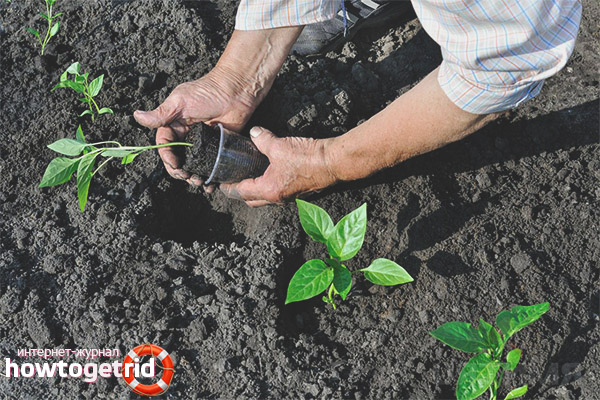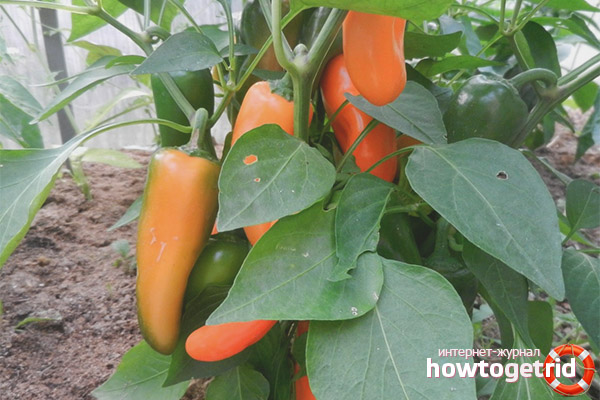The content of the article
Orange is a bright and juicy name that belongs not only to citrus fruit, but also to a variety of sweet bell pepper. The vegetable has a beautiful orange color, for which it got its name. It is distinguished by the extraordinary sweetness of taste and fragrance of the aroma. The taste characteristics of pepper are not inferior to fruit treats; it can be safely called a delicacy. The variety is mainly grown in the central region of Russia.
Fruit Description
The main external characteristics of the fetus:
- the color scheme is represented by an assortment of yellow and red colors;
- cylindrical shape;
- reaches a length of up to 10.0 cm;
- the mass of one pepper is up to 40 g;
- thin skin, wall thickness up to 5 mm;
- smooth shiny surface.
The pulp of the fruit is sweet, it contains a large amount of sugar (its share is 6%), vitamin C, carotene, trace elements useful for the body. The carotene content in the vegetable exceeds the amount of its presence in carrots. This allows you to classify Orange pepper as a healthy, tasty, sweet product.
The variety is suitable for use both fresh and in conservation. You can harvest it in banks in full growth. Small, they easily fit into a container. Its widespread use as the main ingredient in fruit and vegetable salads. Orange does not contain a large amount of moisture, which allows it to dry, getting sweet candied fruits.
The vegetable is tasty for children and adults, it is recommended for food as a diet and baby food. Pepper is hypoallergenic, allowed for eating even by unprotected categories of people: allergy sufferers, pregnant women, women who are breastfeeding.
Plant characteristics
The bush of a ripened plant reaches a height of up to 40 cm, has a compact neat shape. This makes it possible to arrange them close to each other - by adjusting the density of up to 5 bushes for every 1 m2 of soil. Pepper refers to mid-ripening varieties, the period of ripening of the fruit from the moment the first leaves appear is up to 110 days.
Productivity and immunity
A distinctive feature of the variety is its high productivity. It is up to 7.0 kg. fruits per 1 m2. With growth in a sheltered place, the yield indicator increases. For the period of active ripening of fruits, their number is up to 35 pieces of small peppers, densely strewn with bushes.
The variety is not susceptible to the tobacco mosaic virus. He likes heat, sensitive to temperature changes. It has good storage ability, easily tolerates transportation.
Seed sowing technology
To obtain a rich harvest of strong tasty peppers, the landowner will have to work hard. One purchase of seeds is not enough. The culture requires sowing them at certain times to obtain seedlings, planting the resulting plants and further care for them in compliance with all gardening rules. Seed germination averages 90%.
Sowing of seeds is carried out in a certain period of time, depending on the place of further planting of the grown seedlings. When planning planting in a greenhouse or greenhouse, seeds are sown in the first ten days of February.If the culture will be planted in open ground, then sowing must be carried out in mid-March. In regions with harsh climatic conditions, seeds are planted only in greenhouses, the earliest planting date is June.
For growing seedlings, prepared soil is often used. You can prepare the soil yourself. To do this, mix land, peat and sand, taken in one part with humus, taken in two parts. The prepared mixture is filled with selected containers, which can be plastic glasses or peat pots. The use of the latter favorably affects the growth of culture. Transferred to a permanent place of growing plants, peat containers decompose over time in the ground and become fertilizer for pepper.
Before sowing in the soil, the seeds are first germinated. To do this, they are placed in a microclimate with high humidity and temperature + 270C. Under these conditions, the seeds germinate over a period of 5 to 10 days. They are transferred to the ground, forcing to a depth of 1.0 mm.
Seedling care includes three main steps:
- Providing enough light. In the conditions of the winter season, the light obtained from natural daylight is not enough for breakthrough plants. You can increase the duration of the light period by placing reflective materials around the entire perimeter of containers with seeds planted in them. Additionally, it can be installed around an incandescent lamp with bright daylight.
- Top dressing. Frequency of feeding plants - once for two weeks. You can fertilize with complex mixtures: Kornevin, Nitrofoska.
- Compliance with the optimum temperature. For pepper seedlings, this temperature is + 22- + 23 ° C.
Planting seedlings

Young plants are transplanted to places of their constant growth at the age of 50 days. Preliminarily, two weeks before transplanting, the sprouts are hardened by periodically removing them to the street. Stay in an unprotected place is first half an hour, gradually increasing every day to a whole daylight hours. The plant will develop immunity to wind conditions and temperature changes, to direct sunlight.
The soil for cultivating the culture is loosened and nourished. It is mixed with peat, compost, urea treated with sawdust, sand. Added per 1 g per 1 liter. soil hydrogel will help retain moisture in the soil.
Plants carefully poured from containers are placed in prepared wells, abundantly watered with water. Seedlings grown in a peat pot are placed in the ground with it. The earth is compacted, plants should be watered and tied to a trellis.
Care
Care for a young plant planted in the soil begins immediately after it has taken root in a new place. Basic care procedures include the following procedures:
- The formation of the bush. The upper part of the main stem is pinched, due to which there is an active growth of lateral fruit-bearing shoots. Ideally, they should not be more than 5 pieces. If there are more of them, then the smallest ones are deleted.
- Watering. Peppers love a lot of water, abundant watering is carried out 3 times a week, while at least 10 liters of water are delivered per 1 m2 of soil.
- Loosening the soil, weeding weeds. Two treatments complementing each other. They are carried out simultaneously and play an important role in improving the nutrition and respiration of the root system of the plant. Loosening should be carried out with caution, trying not to touch the root system of peppers, located at a depth of only 5.0 cm from the soil surface.
- Top dressing. Special complex fertilizers are used, containing nitrogen, phosphorus, potassium or feeding substances prepared in the hands.As they are suitable: infusion of litter of a cow or chicken, infusion of grass.
- Mulching. Coating the topsoil with substances of organic or inorganic origin. This reduces the amount of weeds appearing around, retains moisture in the soil, preventing its possible drying out.
- Pollination by artificial means. Additional pollination is carried out by slightly shaking the branches of the bush during its flowering. This will ensure the formation of a large number of smooth and beautiful fruits.
Orange is rightfully considered one of the best varieties of pepper. It belongs to the favorite cultures of both professional landowners and novice farmers. They attach particular importance to it due to the sweet taste, aromatic smell, beautiful sunny color. And the ability of culture to high fruiting only complements its positive qualities.
Video: growing pepper from A to Z










Submit